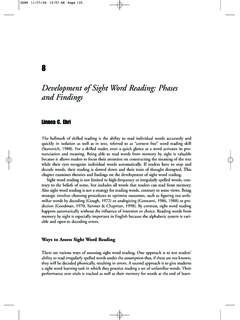Transcription of Assessing Parental Capacity to Change when Children are …
1 Assessing Parental Capacity to Change when Children are on the Edge of Care: an overview of current research evidence research report June 2014. Harriet Ward, Rebecca Brown and Georgia Hyde-Dryden, Centre for Child and Family research , Loughborough University 1. Contents Contents 2. Table of Figures 8. Table of Tables 9. Acknowledgments 10. Note on Terminology 10. Executive Summary 11. Introduction 11. Key findings 11. Background 13. Aim 13. Methodology 14. findings 14. The impact of risk and protective factors on parenting capability and Capacity to Change 14. The potential impact on Children of abuse and neglect 15. Informing structured professional judgments using standardised measures 15.
2 Useful conceptual models to facilitate analysis and case conceptualisation 16. Elements requiring consideration within the Change process: resistance, motivation, engagement and relapse 17. Understanding effective interventions parenting skills, specific and multifaceted interventions 18. The timing of the Change process 19. The implications for social work practice 20. Conclusion 21. Chapter One: Introduction and methodology 22. 2. Introduction 22. Children and Families Act 2014 and revised Public Law Outline 22. Assessing Parental Capacity to Change within a wider context 24. Societal factors and their influence on parenting 24.
3 Interplay of factors 24. Social work assessments in the real world 25. Availability and interpretation of information 26. Factors that skew the decision-making process 27. Checks and balances 29. Purpose of this literature review 32. Methodology 32. Conclusion 34. Key points from Chapter One 35. Chapter Two: Risks of Future Harm 36. Introduction 36. Factors which undermine parenting capability 37. Parents' problems 37. Impact of combinations of problems 39. Environmental factors and their impact 39. Parenting Children with additional needs 40. Recurrent abuse 40. Protective factors 41. The impact of abuse and neglect on Children 's subsequent development 44.
4 Attachment styles and their impact 44. The impact of abuse and neglect as Children grow 45. 3. Identifying Children suffering, or likely to suffer significant harm 49. Tools to assess risk of significant harm 50. Conclusion 52. Key points from Chapter Two 52. Chapter Three: Models of Change : their strengths and weaknesses 54. Introduction 54. Case conceptualisation 54. Parents' attachment styles and their implications 55. Models of Change 56. The Trans-Theoretical Model of Change (TTM) 56. Adaptations to the Trans-Theoretical Model and alternative models 61. A procedure for Assessing parents' Capacity to Change (Harnett 2007) 62.
5 Conclusion 66. Key points from Chapter Three 66. Chapter Four: Ambivalence, denial and unwillingness to Change 68. Introduction 68. How common is denial or unwillingness to Change ? 68. Disguised compliance, failure to cooperate, and unwillingness to Change 69. Factors underlying unwillingness to Change 70. Internal factors 71. External factors 73. Support from other agencies 74. Motivational Interviewing: strengths and weaknesses 75. The Family Partnership (FP) Model 77. Family Group Decision-Making 78. 4. Engagement and satisfaction 79. Children 's participation and outcomes 80. Engagement of professionals 81. When parents cannot Change within a child's timeframe 82.
6 Conclusion 82. Key points from Chapter Four 83. Chapter Five: Motivation and engagement 84. Introduction 84. Motivation: the decisional balance 84. Turning points 86. Engagement 94. Models of engagement 95. Conclusion 98. Key points from Chapter Five 98. Chapter Six: Building Parenting Capability through Evidence-based Interventions 100. Introduction 100. Understanding effective services and interventions 101. General principles concerning evidence of effectiveness 101. Understanding effective social work 104. Barriers to effective social work 105. Intensive Family Preservation Services (IFPS) 106. Outcomes of care 108. Outcomes of kinship care 109.
7 Outcomes of adoption 110. Returning home from care 111. 5. Specific interventions to support parents and Children 111. Targeted preventive programmes 112. Specific programmes to address abusive parenting and prevent impairment 113. Specific interventions to address Parental problems that increase the risk of maltreatment 116. Intensive, multi-faceted interventions for families with complex needs 121. Conclusion 124. Key points from Chapter Six 124. Chapter Seven: Relapse and the maintenance of Change 126. Introduction 126. The impact of different types of problem on sustained Change 127. How long is needed to establish whether parents will successfully maintain Change ?
8 127. The process of recovery and relapse 128. Virtuous circles 129. Factors supporting or undermining the maintenance of Change 129. Examples of factors supporting Change 130. Examples of factors undermining Change 131. The role of parenthood in supporting and undermining Change 132. Relapse and harm to the child 133. Conclusion 134. Key points from Chapter Seven 134. Chapter Eight: Conclusion: Making use of the research findings to inform professional practice and assessments required by the courts 136. Introduction 136. Assessment of parents' Capacity to meet needs (parenting capability) 137. Assessments of Children 's needs 138.
9 6. Assessing the likelihood of significant harm 139. Analysis of why there might be a gap between Parental capability and the child's needs139. Case conceptualisation 139. Gaps between parenting capability and Children 's needs 140. Implications for day to day practice 140. Court requirements and implications for social work practice 140. Understanding the process of Change 141. Relationships between social workers and parents 143. Relationships with other professionals 144. Assessing parents' Capacity to Change within a child's timeframe 145. Implications for continuing professional development 147. Conclusion 148. Key Points from Chapter Eight 148.
10 Appendices 150. Appendix One: search terms 150. Table 1: search terms 151. Appendix Two: scientific advisory group and steering group members 154. References 155. List of Cases 192. 7. Table of Figures Figure : The Assessment Framework 25. Figure : An Integrated Model of Parental Engagement with Child Welfare Services 97. 8. Table of Tables Table : Factors associated with future harm 42. Table : Impact of abuse and neglect during key developmental timeframes for children47. Table : Hierarchy of levels of evidence 103. 9. Acknowledgments This literature review was funded by the Department for Education as part of the Childhood Wellbeing research Centre programme.












